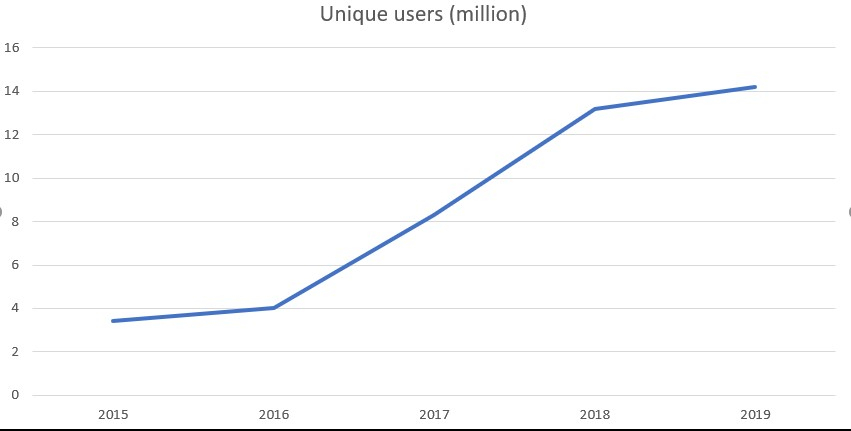It’s a new year and a new decade. This year, DOAJ turns 17 and much like a teenager, we have seen a major growth spurt over the last 4 years, peaking at a total of 14.25 million unique users at the end of 2019. 2020 will see further transformation into a maturer, more rounded service.

2019
2019 was another busy year, focussed on preparing DOAJ for adulthood. We added muscle to the bones by increasing our capacity in the platform and in our editorial team and thereby increasing our throughput. Never before has DOAJ been such a lean operation on such a large scale.
Much of the process to get to where we are today was written about in September, in a guest post by Richard Jones from Cottage Labs, so I’m just focussing on the last quarter here.
Since October 2019, we updated the DOAJ search interface–a program called Edges–and upgraded to Python 3. We extended our automated testing scripts and fixed a variety of bugs or discrepancies which they subsequently uncovered.
I am pleased to say that these pieces of work have been so successful that in 2019 we had 99.999% uptime, a huge improvement on previous years.
On the front end, we added more translations of the COPE/DOAJ/OASPA/WAME co-authored Principles of Transparency and Best Practice in Scholarly Publishing which is now available in 20 different languages. We cleaned up our articles database by removing many old, malformed or duplicated entries.
We also improved our crawler which is pointed at Europe PMC’s API and added 13,200 PLoS articles which were missing from the database.
The start of the redesign project saw us focussing our efforts on design research:
- getting in touch with users
- doing exhaustive inventories of our content and information architecture
- understanding DOAJ’s offers and services on a deeper level
- setting realistic goals and metrics for the website’s design
- benchmarking / looking at how other open access orgs and not-for-profits present themselves
- finding visual inspiration from external sources / moodboarding
- setting ourselves up for a more modular design mindset to facilitate development of new services on DOAJ.org
We also inaugurated our Advisory Board and Council.
2020
During the first quarter of 2020, the following pieces of work will be released live to the site:
- Some additional language codes will be added to our XSD file.
- A Spam reCAPTCHA module is being added to the feedback form.
- The form for publishers to manually provide article metadata to us is getting an overhaul.
- The addition of Crossref XML compatibility so publishers can send us Crossref XML if they wish.
- A reconstructed, redesigned application form with improved functionality and usability.
Away from the platform, we are extending our partner program, after what is proving to be a successful pilot project with our friends at TSV in Finland. More projects like this will result in an increase in the number of journals indexed in DOAJ, the goal of the work we wrote about when we reached our first SCOSS funding target in May 2019.
The aim of these projects is to:
- Maintain the recency and relevancy of the database by targetting specific journals which are not yet indexed in DOAJ
- Recruit back into DOAJ as many of the 2850 journals as possible which we removed during the Reapplication Project,
- Increase our coverage of journals from the Arts, Social Sciences and Humanities.
- Increase our coverage of non-English language journals.
- Increase our coverage of journals from specific subject areas.
DOAJ will also continue its work with its partner program Think.Check.Submit which is developing it tools and resources.
If you have any questions about any of this work, do please leave a comment!
I wish all our readers a happy and healthy 2020.
